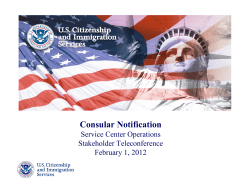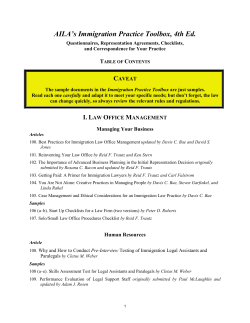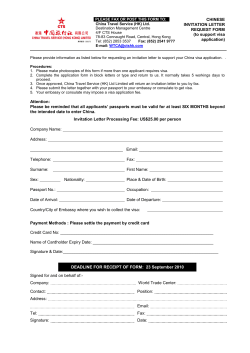
How do I help my relative become a U.S. permanent resident?
I am a U.S. citizen A1 How do I help my relative become a U.S. permanent resident? As a citizen of the United States, you may help a relative become a lawful permanent resident of the United States by obtaining what is often referred to as a “Green Card.” To do so, you need to sponsor your relative and be able to prove that you have enough income or assets to support your relative(s) when they come to the United States. You begin the process by filing Form I-130, Petition for Alien Relative. This form establishes the family relationship that exists between you and your relative. Filing instructions and forms are available on our Web site at www.uscis.gov. Sometimes the I-130 can be filed together with an application for permanent residence (Form I-485, Application to Register Permanent Residence or Adjust Status). This is discussed below. Which relatives may I petition for? A U.S. citizen can file a petition for the following relatives: •Husband or wife; •Children, married or unmarried.1 A U.S. citizen who is at least 21 years or older may also petition for the following relatives: •Parents; •Brothers or sisters. When you submit your petition, you are required to provide evidence to prove your relationship to the person for whom you are filing. What does the petition do for my relative? Filing a Form I-130 and proving a qualifying relationship gives your relative a place in line with others waiting to immigrate from the same country or region based on the same type of relationship. When your relative reaches the front of the line, he or she may be eligible to immigrate after passing the required background checks and meeting requirements for admission. For example: You file a petition for your unmarried son over 21 years of age. If we approve it, your petition gives him a place in line with people from the same country category who are also unmarried sons or daughters over the age of 21 of U.S. citizens. Your relative’s place in line will be based on the date you file your petition. So there is an advantage to filing as soon as possible. There is no waiting period for immediate relatives of U.S. citizens, which include a U.S. citizen’s spouse, parent, or unmarried child under 21 years of age. What about my relative’s family? In most cases, when your relative reaches the front of the line, your relative’s spouse and unmarried children under 21 years of age can join him or her by also applying for an immigrant visa. (If the family member is already in the United States, he or she may be able to file a Form I-485 application to adjust status based on the relative’s approved visa petition.) For example: You file a petition for your married daughter. You cannot directly petition for her husband and children. However, when your daughter’s place in line allows her to apply for a Green Card, her husband and children can apply for immigrant visas at the same time with your daughter. As a U.S. citizen, you must file a separate petition for each one of your direct relatives, including your own children. For example: To sponsor your mother and father, file a separate petition for each. If they have other children—your brothers and sisters—file a separate petition for each of them. Visas are immediately available for mothers and fathers of U.S. citizens, but visas are not immediately available for brothers and sisters of U.S. citizens; therefore, they will have to wait for visa availability. For example: You marry someone with a child. The child will usually qualify as your stepchild if he or she was unmarried and under 18 years of age at the time of your marriage. In this example, you are required to file two petitions: one petition for your wife and another for the child. 1 Immigration law provides different immigrant classifications for children depending on their age and whether they are married. Customer Guide A3, I Am a U.S. Citizen...How Do I...Immigrate an Adopted or Prospective Adopted Child or Help My Adopted Child Become a Citizen or Permanent Resident of the United States?, discusses how an adopted child may immigrate or otherwise become a permanent resident. A1—I am a U.S. citizen…How do I help my relative become a U.S. permanent resident? M-555B (October 2013) N 1 After I file, how long will it take before my relative can immigrate? The law gives special consideration to immediate relatives of U.S. citizens, which includes a U.S. citizen’s spouse, unmarried children under 21 years of age, and parents. •There is no waiting list to immigrate these relatives. •The U.S. Department of State will invite them to apply for an immigrant visa as soon as we approve your I-130 petition. •If your petition has been approved, and your relatives are currently in the United States after making a legal entry (and they meet certain other requirements), they may be able to file applications with USCIS to adjust to permanent resident status. For other relatives, the combination of high demand and the limits set by law on how many people can immigrate each year means your relative may have to wait several years in line while petitions that were filed before theirs are processed. When your relative reaches the front of the line, the U.S. Department of State contacts your relative and invites him or her to apply for an immigrant visa. Current wait times for visa categories are available under “Visa Bulletins” on the State Department’s Web site at www.travel. state.gov/visa. Please Note: If you are immigrating to the United States and will be admitted as a lawful permanent resident, you must pay the $165 USCIS Immigrant Fee. You pay this fee online through the USCIS Electronic Immigration System (USCIS ELIS). We strongly encourage you to pay this fee after you receive your immigrant visa packet from the U.S. Embassy or consulate abroad (including Canada and Mexico) and before you depart for the United States. Paying before you depart for the United States will ensure that you receive your Permanent Resident Card (commonly referred to as a Green Card) without delay. Information about the fee can be found on our Web site at www.uscis.gov/immigrantfee. Can my relative wait in the United States until becoming a permanent resident? No. If your relative is outside the United States, filing an I-130 does not allow your relative to live or work in the United States. An I-130 petition only establishes your relationship with your relative. Your relative should wait outside the United States to immigrate legally. If your husband or wife, unmarried child under 21 years, or parent is already in the United States after having entered legally, they can apply to adjust their status to permanent resident at the same time you file their I-130 petition. Does filing a relative petition commit me to anything? Yes. Under the law, each person who immigrates based on a relative’s petition must have a financial sponsor. If you choose to sponsor your relative’s immigration by filing a relative petition (I-130), when the time comes for your relative to immigrate, you must agree to be his or her financial sponsor by filing Form I-864, Affidavit of Support. If you do not meet the financial qualifications, other individuals will then need to make this commitment. For more information, please see Customer Guide F3, General Information... How Do I...Financially Sponsor Someone Who Wants to Immigrate?. How do I file? There are two basic ways to legally assist your relatives to immigrate into the United States: 1.If your relatives live in another country, you will file an I-130 petition with USCIS. Form I-130 can be filed with a USCIS Lockbox based on the petitioner’s place of residence. Please refer to pages 4 and 5 of the instructions for mailing addresses. Please check our Web site for any updates on instructions or fees. Make sure your petition is complete, signed, and submitted with correct fees. You will need to submit evidence of your U.S. citizenship, and evidence proving your relationship to each person for whom you are filing a petition. 2.If your relatives are already in the United States and entered legally, then they may be able to file an I-485 application to adjust their status to lawful permanent resident at the same time as you file the I-130 relative petition. Petitions filed at the same time with permanent residence applications (I-485) must be filed at a location that is different from where you would file an I-130 petition by itself. Please read the instructions for the two addresses where concurrent filings can be mailed. What happens after I file? We will mail you a receipt confirming that we have received your petition. If your petition is incomplete, we may have to reject it, or ask you for more evidence or information, which will delay processing. Please send all required documents the first time to avoid delay. We will notify you when we make a decision. Normally, when we approve the petition, we send it to the U.S. Department of State’s National Visa Center (NVC). When your relative’s place in line permits issuance of a visa number, the NVC will notify you and your relative, inviting him or her and qualifying dependents to apply for immigrant visas. You can find more information about immigrant visa processing from the State Department’s Web site at www.state.gov. How long will it take USCIS to process my petition? Since processing time depends on a number of factors, it is difficult to provide a timeframe. We post current processing times on our Web site at www.uscis.gov, which is the best way to monitor progress of your petition. What if I filed a petition for a relative when I was a permanent resident, but I am now a U.S. citizen? If you become a U.S. citizen while your relative is waiting for a visa, you can upgrade your relative’s visa classification and advance the processing of that petition by notifying the appropriate agency of your naturalization. When you are a U.S. citizen, your husband or wife and any unmarried children under age 21 will have visas immediately available to them. •If you become a U.S. citizen after your Form I-130 petition is already approved and it has been forwarded to the State Department’s National Visa Center (NVC), you should notify the NVC that you have become a U.S. citizen. Requests to upgrade petitions due to the naturalization of the petitioner should be sent to: National Visa Center 31 Rochester Avenue, Suite 200 Portsmouth, NH 03801-2915 Please include a letter with information regarding your relative, a copy of your Naturalization Certificate, and a copy of the petition approval notice. Once the NVC is notified that the petitioner has been naturalized, the NVC will immediately send the visa A1—I am a U.S. citizen…How do I help my relative become a U.S. permanent resident? M-555B (October 2013) N 2 information on your relative to the designated U.S. Embassy or consulate abroad. To confirm that your approved petition has been forwarded to the NVC, you can contact the NVC’s automated recorded message system at 1-603-334-0700 and, with a touchtone telephone, enter your USCIS receipt number. •If you become a U.S. citizen and your relative’s petition has not yet been approved by USCIS, you will need to send the notification to the Service Center address located on the receipt notice you received when you filed your Form I-130 petition. Please include a letter with information regarding your relative, a copy of your Naturalization Certificate, and a copy of the petition receipt notice. Call Customer Service at 1-800-375-5283 for assistance or if you are unsure about the status or location of your petition. •If your relative is your spouse and has children who are your natural children, stepchildren, or adopted children, and you did not file separate petitions for them, you must file a separate petition for each of them with evidence of your U.S. citizenship. Please include a copy of the receipt notice for the original petition. For more copies of this guide, or information about other customer guides, please visit www.uscis.gov/howdoi. You can also visit www.uscis.gov to download forms, e-file some applications, check the status of an application, and more. It’s a great place to start! If you don’t have Internet access at home or work, try your local library. If you cannot find what you need, please call Customer Service at: 1-800-375-5283 Hearing Impaired TDD Customer Service: 1-800-767-1833 Key Information Key USCIS forms referenced Form # in this guide Petition for Alien Relative I-130 Application to Register Permanent Residence or Adjust Status I-485 Affidavit of Support I-864 Other U.S. Government Services–Click or Call General Information www.usa.gov New Immigrants www.welcometoUSA.gov U.S. Dept. of State www.state.gov www.travel.state.gov/visa 1-800-333-4636 Disclaimer: This guide provides basic information to help you become generally familiar with our rules and procedures. For more information, or the law and regulations, please visit our Web site. Immigration law can be complex, and it is impossible to describe every aspect of every process. You may wish to be represented by a licensed attorney or by a nonprofit agency accredited by the Board of Immigration Appeals. 1-202-647-6575 A1—I am a U.S. citizen…How do I help my relative become a U.S. permanent resident? M-555B (October 2013) N 3
© Copyright 2025














